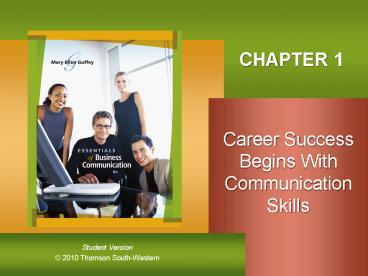Career Success Begins With Communication Skills - PowerPoint PPT Presentation
1 / 20
Title:
Career Success Begins With Communication Skills
Description:
CHAPTER 1 Career Success Begins With Communication Skills Chapter 1, Slide * Mary Ellen Guffey, Essentials of Business Communication, 8e 0 Mary Ellen Guffey ... – PowerPoint PPT presentation
Number of Views:1856
Avg rating:3.0/5.0
Title: Career Success Begins With Communication Skills
1
CHAPTER 1
- Career Success Begins With Communication Skills
2
Good communication skills are essential for
- Job placement
- Job performance
- Career advancement
- Success in the new world of work
3
Build Your Career Communication Skills
Your Guide
Textbook
Your Coach
Instructor
See http//www.meguffey.com
Bonus Resources
4
0
5
The Process of Communication
Verbally or nonverbally. By speaking, writing,
gesturing.
How may the sender encode a message?
Letters, e-mail, IM, memos, TV, telephone, voice,
body. Others?
What kinds of channels carry messages?
6
The Process of Communication
Hearing, reading, observing
How does a receiver decode a message?
When a message is understood as the sender
intended it to be.
When is communication successful?
Ask questions, check reactions, dont dominate
the exchange.
How can a communicator provide for feedback?
7
Barriers to Effective Listening
Physical barriers hearing disabilities, noisy surroundings
Psychological barriers tuning out ideas that counter our values
Language problems unfamiliar or charged words
Nonverbal distractions clothing, mannerisms, appearance
8
Keys to Building Powerful Listening Skills
- Stop talking.
- Control your surroundings.
- Establish a receptive mind-set.
- Keep an open mind.
- Listen for main points.
- Capitalize on lag time.
9
Keys to Building Powerful Listening Skills
- Listen between the lines.
- Judge ideas, not appearances.
- Hold your fire.
- Take selective notes.
- Provide feedback.
10
Nonverbal Communication
- Eye contact, facial expression, and posture and
gestures send silent messages.
- Time, space, and territory send silent messages.
- Time (punctuality and structure)
- Space (arrangement of objects)
- Territory (privacy zones)
11
Nonverbal Communication
- Appearance sends silent messages.
- Appearance of business documents
- Appearance of people
12
Keys to Building Strong Nonverbal Skills
- Establish and maintain eye contact.
- Use posture to show interest.
- Improve your decoding skills.
- Probe for more information.
- Avoid assigning nonverbal meanings out of context.
13
Keys to Building Strong Nonverbal Skills
- Associate with people from diverse cultures.
- Appreciate the power of appearance.
- Observe yourself on videotape.
- Enlist friends and family.
14
Dimensions of Culture
15
Proverbs Reflect Culture
What do these U.S. proverbs indicate about this
culture and what it values?
- The squeaking wheel gets the grease.
- Waste not, want not.
- He who holds the gold makes the rules.
- If at first you dont succeed, try, try again.
- The early bird gets the worm.
16
Improving Communication With Multicultural
Audiences
- Oral Messages
- Use simple English.
- Speak slowly and enunciate clearly.
- Encourage accurate feedback.
- Check frequently for comprehension.
17
Improving Communication With Multicultural
Audiences
- Oral Messages
- Observe eye messages.
- Accept blame.
- Listen without interrupting.
- Smile when appropriate.
- Follow up in writing.
18
Improving Communication With Multicultural
Audiences
- Written Messages
- Consider local styles.
- Consider hiring a translator.
- Use short sentences and short paragraphs.
- Avoid ambiguous wording.
- Follow up in writing.
- Cite numbers carefully.
19
Improving Communication Among Diverse Workplace
Audiences
- Understand the value of differences.
- Seek training.
- Learn about your own cultural self.
- Make fewer workplace assumptions.
- Build on similarities.
20
- END































